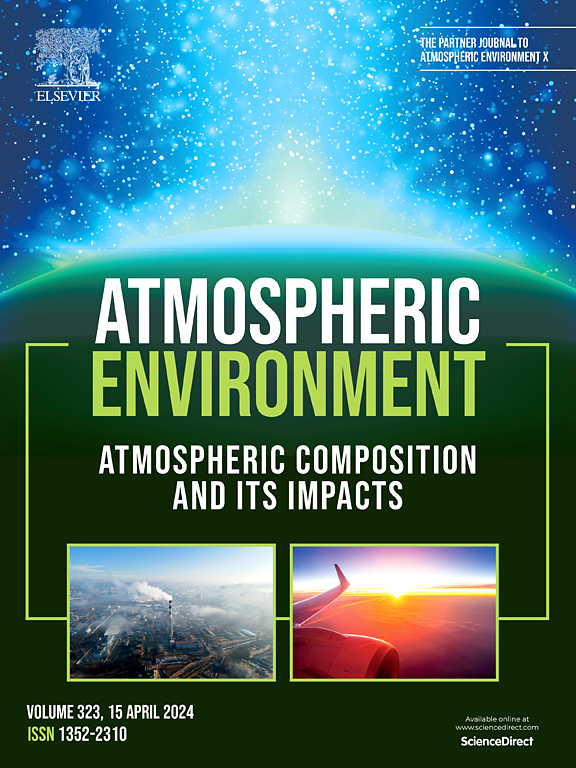Seasonal chemical characteristics and formation of potential secondary aerosols of a remote area in South Korea using an oxidation flow reactor
IF 4.2
2区 环境科学与生态学
Q2 ENVIRONMENTAL SCIENCES
引用次数: 0
Abstract
Due to the complicated characteristics of secondary aerosols (SAs), their study requires research into their formation and oxidation processes under diverse atmospheric conditions and reactions. Moreover, the increasing atmospheric pollution in Korea has been attributed to factors such as long-range transport of pollutants from China and emissions from domestic sources like cities, power plants, and industrial complexes. In this study, an oxidation flow reactor (OFR) was utilized to assess the chemical characteristics of potential SAs in Korea's background atmosphere. Sampling was conducted from 2019 to 2021 on Baengnyeong Island (37.967° N, 124.630° E), located west of the Korean Peninsula and approximately 180 km from China's Shandong Peninsula. The OFR, coupled with a high-resolution time-of-flight aerosol mass spectrometer (HR-ToF-AMS) and various gas monitors (SO2, NO, NO2, NOX, CO, NH3, and O3), facilitated the analysis of the chemical composition of potential SAs. Additionally, to analyze long-range transport from Baengnyeong Island to Seoul, data on SAs and gaseous pollutants from the island were compared with those from Seoul. Results indicate that the potential SAs generated by the OFR were influenced by ozone (O3) and relative humidity (RH) levels. The concentration of these potential SAs increased with aging time and varied depending on O3 and RH levels. During spring, elevated PM1 concentrations in Seoul were noted, driven by additional SAs from photochemical reactions in inland regions. In contrast, during winter, the formation of certain SAs was predominantly due to long-range transport or the accumulation of domestic pollutants in the atmosphere.
韩国偏远地区使用氧化流反应器的季节性化学特征和潜在二次气溶胶的形成
由于二次气溶胶(SAs)的复杂特性,需要研究其在不同大气条件和反应下的形成和氧化过程。此外,韩国的大气污染加剧是由于中国的污染物远距离输送和城市、发电厂、工业园区等国内污染源的排放等因素造成的。在本研究中,利用氧化流动反应器(OFR)来评估韩国背景大气中潜在sa的化学特性。样本于2019年至2021年在白翎岛(37.967°N, 124.630°E)进行,白翎岛位于朝鲜半岛以西,距离中国山东半岛约180公里。OFR与高分辨率飞行时间气溶胶质谱仪(HR-ToF-AMS)和各种气体监测仪(SO2, NO, NO2, NOX, CO, NH3和O3)相结合,有助于分析潜在sa的化学成分。此外,为了分析从白翎岛到首尔的远程运输,将白翎岛的SAs和气态污染物数据与首尔的进行了比较。结果表明,臭氧(O3)和相对湿度(RH)水平对OFR产生的潜在sa有影响。这些潜在sa的浓度随老化时间而增加,并随O3和RH水平的变化而变化。在春季,由于内陆地区光化学反应产生的sa增加,首尔的PM1浓度升高。相反,在冬季,某些sa的形成主要是由于远距离输送或大气中生活污染物的积累。
本文章由计算机程序翻译,如有差异,请以英文原文为准。
求助全文
约1分钟内获得全文
求助全文
来源期刊

Atmospheric Environment
环境科学-环境科学
CiteScore
9.40
自引率
8.00%
发文量
458
审稿时长
53 days
期刊介绍:
Atmospheric Environment has an open access mirror journal Atmospheric Environment: X, sharing the same aims and scope, editorial team, submission system and rigorous peer review.
Atmospheric Environment is the international journal for scientists in different disciplines related to atmospheric composition and its impacts. The journal publishes scientific articles with atmospheric relevance of emissions and depositions of gaseous and particulate compounds, chemical processes and physical effects in the atmosphere, as well as impacts of the changing atmospheric composition on human health, air quality, climate change, and ecosystems.
 求助内容:
求助内容: 应助结果提醒方式:
应助结果提醒方式:


